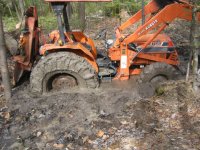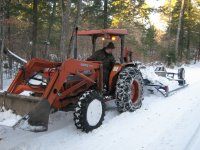Jay4200
Veteran Member
- Joined
- Nov 23, 2005
- Messages
- 2,054
- Location
- Hudson/Weare, NH
- Tractor
- L4200GST w/ LA680 & BX2200D w/ LA211
I put my L4200 into service blowing snow for the first time this season. Two storms so far and going strong. I bought 2-link ladders for all 4 wheels (turf tires), w/ v-bars on the front. I mounted the front chains, but didn't do the back. I had carpal tunnel surgery 6 weeks ago, and still can't handle the 80 pound rear chains. The front v-bars look so nasty, I figured that they would do the job, as I'd be running in reverse and in 4WD.
Interestingly, the front-only option seems to be working great. It is slippery enough that I literally can't even get out of my barn with the blower down in 2WD using my chainless rears. I pop it into 4WD and off I go. I have yet to see a wheel slip. I haven't had to try to climb my hill with a solid ice base yet, but it looks like the v-bars will handle even that.
While I am happy with the result, if it turns out that the front-only option is adequate for all conditions, I'm not so excited about the prospect of having wasted $400 for the rear chains that I don't need. OTOH, if an extreme ice condition requires the rears, eventually I'm going to have to lift those 80 pound beasts. Catch 22...
JayC
Interestingly, the front-only option seems to be working great. It is slippery enough that I literally can't even get out of my barn with the blower down in 2WD using my chainless rears. I pop it into 4WD and off I go. I have yet to see a wheel slip. I haven't had to try to climb my hill with a solid ice base yet, but it looks like the v-bars will handle even that.
While I am happy with the result, if it turns out that the front-only option is adequate for all conditions, I'm not so excited about the prospect of having wasted $400 for the rear chains that I don't need. OTOH, if an extreme ice condition requires the rears, eventually I'm going to have to lift those 80 pound beasts. Catch 22...
JayC


